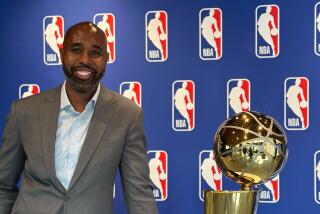Bullish Market in NBA
- Share via
Insisting that he has more money than he could ever use and that power means nothing to him, Rick Pitino says he is, first and foremost, a basketball coach. But the Boston Celtics are betting $70 million that the man who led Kentucky to the 1996 NCAA championship is more than that--and several other NBA teams are making the same gamble these days.
Pitino’s hiring was one of three big-impact coaching deals made last week. Larry Brown reached a five-year, $25-million deal with the Philadelphia 76ers, and former Celtics great Larry Bird signed a five-year, $22.5 million pact with the Indiana Pacers. With the Portland Trail Blazers, Golden State Warriors and Vancouver Grizzlies seeking coaches, and big names such as the Chicago Bulls’ Phil Jackson possibly available, there’s no telling how high the market will go.
“It’s all a matter of supply and demand and timing,” said Los Angeles Lakers Coach Del Harris. “You have the same thing in player contracts, where a guy like (Seattle’s) Jim McIlvaine or (Orlando’s) Jon Koncak get huge salaries because of timing, and then guys that have actually done considerably more, like (Bulls all-star) Scottie Pippen, are down on the salary schedule.”
Former Celtics coach M. L. Carr says the new contracts are fair compensation for a position that has changed dramatically.
“The job is more demanding than it’s ever been and so the rewards for doing it should be higher,” said Carr, who was forced to resign as the Celtics’ coach and director of operations, making room for Pitino. “Before, you just coached. Now you have to worry about player contracts and the salary cap, about marketing.”
Pitino is replacing Red Auerbach as the Celtics’ president; Brown has the final say in the 76ers’ player personnel decisions and Bird has partial ownership of the Pacers. Similar benefits and duties are built into the contracts of Miami Heat Coach Pat Riley (10 years, $30 million) and New Jersey Nets Coach John Calipari (five years, $15 million).
Since the Bird-Magic Johnson rivalry in the 1980s, the NBA has marketed itself around stars. At times that has been to the detriment of coaches, as players -- backed by high-paying, guaranteed multiyear contracts -- have virtually set a team’s agenda. Now, given the new coaching contracts, when things begin to go wrong for a team, owners might have to consider firing players.
“There have been many (coaches) who didn’t make nearly as much money as these guys are getting who still got the respect without any problems,” said Dallas Mavericks General Manager Don Nelson, a former coach. “But I think this does give coaches more authority. It definitely gives them the authority not to be fired early”
Pitino joked about the difference between coaching at Kentucky and at his previous stop, the New York Knicks (1987 to 1989).
“[At Kentucky] we gather in a circle at midcourt and I tell them we’re going to work on 10 different segments--half-court offense and defense, full-court offense and defense, and so on,” Pitino said. “We gather hands and say ‘Break!’ and get to work. With the Knicks, it was the same thing--except then I’d look at Patrick Ewing and say, ‘Is there anything else you want to do today?’ ”
Pitino said the NBA will remain a players’ league, but that he and other highly paid coaches “better deliver. Coaches have been underpaid for years. It’s what we do. It’s our passion. But now, when you get this kind of money, you’d better deliver--and I know that.”
Some coaches said players’ huge salaries--the average NBA player’s salary is $1.4 million a season--have caused problems in recent years, particularly before the league instituted a rookie wage scale three years ago. Before that, incoming college stars such as the Milwaukee Bucks’ Glenn Robinson (Purdue) received exorbitant amounts of guaranteed money (almost $70 million in his case) just to sign a contract.
With those bucks, plus hundreds of thousands more from sneaker deals and commercials, coaches complained there was little incentive for players to worry about things such as setting screens, blocking out underneath the backboards--or listening to a coach complain that it wasn’t being done.
“The coach has to be allowed to coach--and I underline allow,” said former NBA coach Chuck Daly, now a television analyst. “It gets to the point where the players allow you to coach for only so long.”
“Players know if you’re in just a little bit of trouble,” Utah Jazz Coach Jerry Sloan said. “If you lose two or three games and they know ownership’s not going to step up and say, ‘This guy is going to coach this team regardless,’ then it’s easier for them to go out and lose. If you have the ability to move [unhappy players], you’ll set the tone. If ownership wavers a little bit, then it’s very difficult for you.”
Even with Dennis Rodman on his teams, Daly never had that problem when he was coaching the Detroit Pistons. It was clear Daly controlled the 240 minutes of playing time available each game. And it was equally clear he was ensconced in his position and wasn’t going anywhere. Another factor in Daly’s favor was his ability to gain the support of key players such as Isiah Thomas, Bill Laimbeer and Adrian Dantley. That, Daly said, will become even more important in upcoming seasons.
Because of the salary cap and rookie wage scale, “you’re going to have no middle class. That means the coach and the top two or three players on a team are really going to have to be in tune . . . look at what Riley did with the Heat. [All-star center Alonzo] Mourning and [guard Tim] Hardaway really bought into the system. They do double the drills.
“It’s the changing face of the league as far as the inner workings of teams.”
More to Read
Go beyond the scoreboard
Get the latest on L.A.'s teams in the daily Sports Report newsletter.
You may occasionally receive promotional content from the Los Angeles Times.










